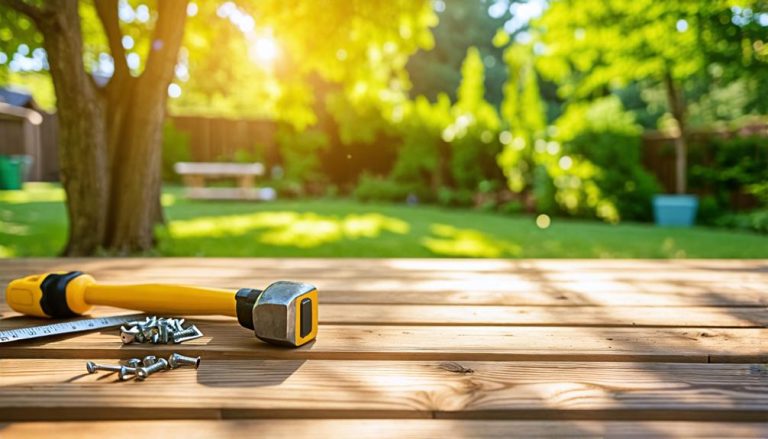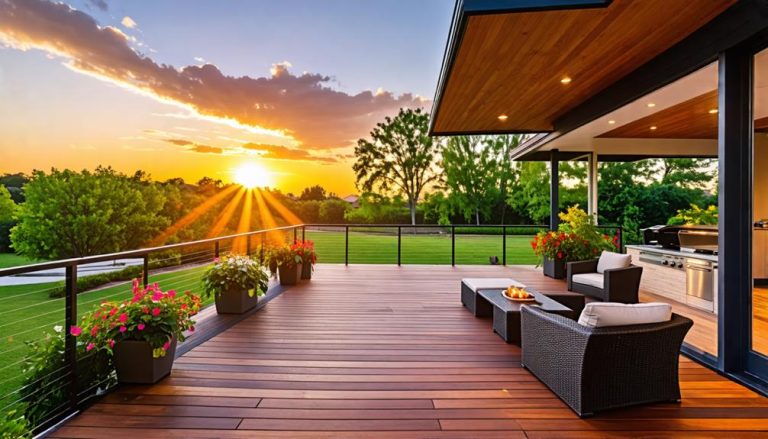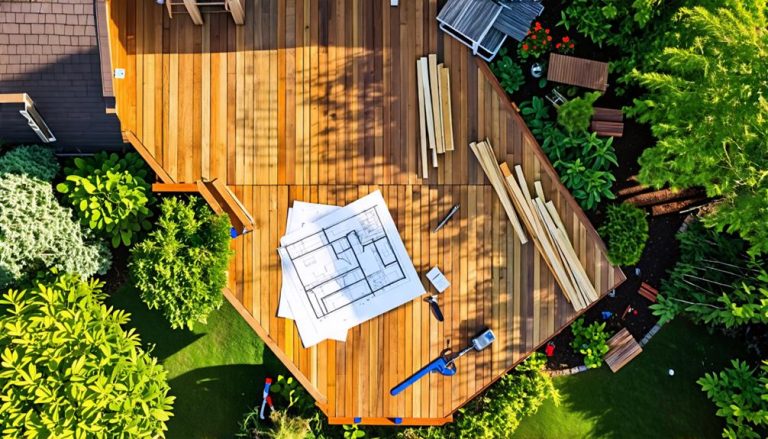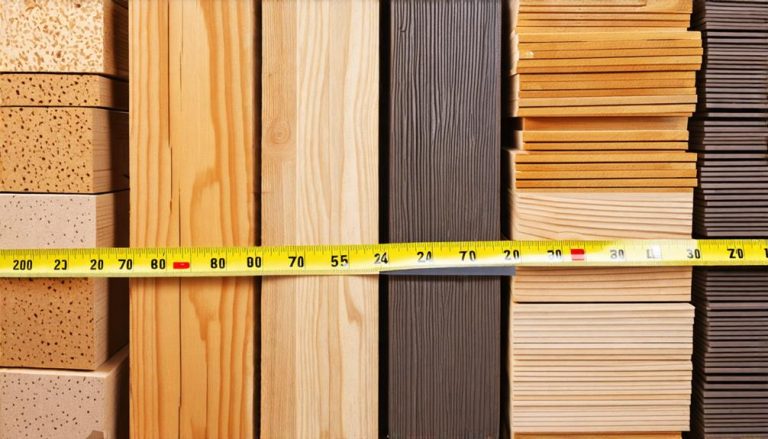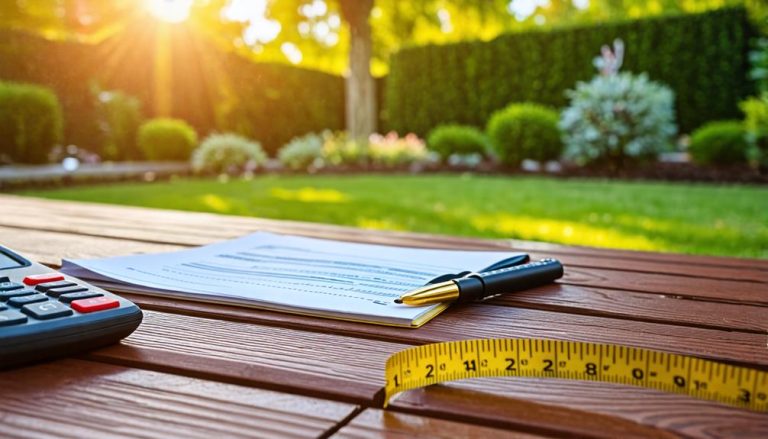How Much Should It Cost to Build a Deck?
Building a deck typically costs between $30 and $60 per square foot, with the total price varying based on size, materials, and design complexity. You’ll find that pressure-treated lumber is the most economical option at $15 to $25 per square foot, while composite decking ranges from $30 to $60. Labor expenses often account for 40-60% of the total project cost, influenced by factors such as location and specialized skills required. When budgeting, consider additional expenses like permits, railings, and stairs, which can add 10-20% to the overall cost. Keep in mind that a well-constructed deck not only expands your living space but can also increase your property’s value. The following sections will provide a more detailed breakdown of costs and considerations.
Typical Deck Construction Cost
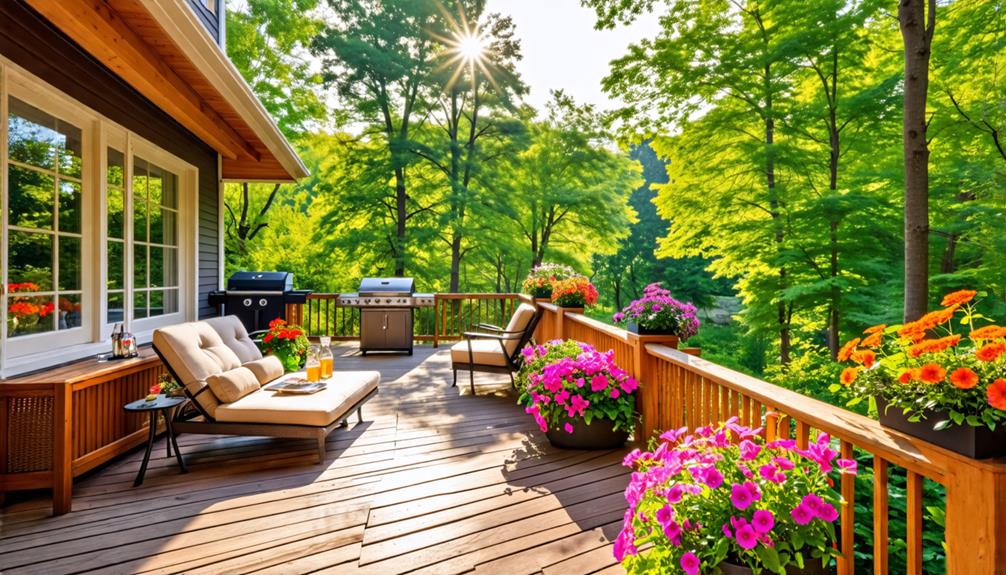
When planning your deck project, you’ll need to examine the typical construction costs, which can vary widely based on materials, size, and complexity. It’s important to consult with a custom deck design and build contractor like Dream Decks who utilizes premium materials for decking and has an extensive background in high-quality deck construction.
Understanding the average cost per square foot, which ranges from $30 to $60 for basic designs, will help you set a realistic budget. You should also factor in the breakdown of material costs, including lumber, hardware, and finishes, as well as labor expenses, which can account for 50% or more of the total project cost depending on your location and the contractor’s experience.
Average Cost per Square-Foot
Although deck costs can vary widely based on materials and design, you’ll typically spend between $30 and $60 per square foot for a standard deck. This range accounts for basic materials, labor, and standard features.
However, several factors can influence the per-square-foot cost. What type of decking material are you considering? Pressure-treated lumber, the most economical option, may cost $15 to $25 per square foot, while composite decking can range from $30 to $60 per square foot. Higher-end materials like ipe or redwood can push costs to $50 or more per square foot.
Consider the deck’s complexity as well. Are you planning a multi-level design or incorporating built-in features? These elements can considerably increase the per-square-foot cost. Location also plays a role; labor rates vary by region. Additionally, don’t forget about extras like railings, stairs, and lighting. These can add $20 to $50 per linear foot. When budgeting, factor in permit fees, which typically range from $200 to $500.
Material Cost Breakdown
Understanding the material cost breakdown for a typical deck construction can help you budget more accurately. The primary components of your deck’s material costs will include lumber, fasteners, and hardware.
Pressure-treated lumber, the most common decking material, typically accounts for 50-60% of your total material expenses. You’ll need to factor in costs for structural lumber (joists, beams, and posts), decking boards, and railing materials.
Fasteners and hardware, such as joist hangers, post anchors, and deck screws, can comprise 15-20% of your material budget. Don’t overlook additional elements like concrete for footings, which may represent 5-10% of costs.
If you’re opting for composite decking or exotic hardwoods, expect to pay substantially more—sometimes two to three times the cost of pressure-treated lumber. Will you include built-in seating or planters? These features can add another 10-15% to your material expenses.
Remember to account for finishing materials like stain or sealant, which protect your investment but increase overall costs. By breaking down these material components, you’ll gain a clearer picture of where your money is being allocated in the deck-building process.
Labor Expense Factors
Labor costs can substantially impact your deck construction budget, often accounting for 40-60% of the total project expense. Several factors influence these costs, including the complexity of your deck design, the contractor’s experience level, and your geographic location. A simple, ground-level deck will require less labor than a multi-level structure with intricate features like built-in seating or custom railings.
The time required to complete your deck project directly affects labor costs. How long will it take to prepare the site, install footings, frame the structure, and apply finishing touches? Consider whether you’ll need specialized skills for tasks such as electrical work for lighting or plumbing for an outdoor kitchen. These factors can increase your labor expenses in a major way.
Additionally, your location plays a pivotal role in determining labor rates. Urban areas or regions with a higher cost of living typically command higher wages for skilled tradespeople. Have you factored in potential overtime costs if the project extends beyond regular working hours? It’s of the utmost importance to discuss these variables with your contractor and obtain detailed estimates that break down labor costs by task and hourly rates. This transparency will help you budget effectively and avoid unexpected expenses during your deck construction project.
Benefits

Building a deck offers numerous advantages that can dramatically improve your home and lifestyle. With Dream Decks Design & Contracts, a family-owned business, you’re guaranteed a quality product that aligns cost with value. Their experienced team navigates any scenario or challenge, delivering more value per dollar spent on your deck.
You’ll gain valuable outdoor living space, perfect for relaxation and entertainment, while simultaneously boosting your property’s overall value. Additionally, a well-designed deck serves as a versatile area for various activities and enhances your home’s aesthetic appeal, creating a smooth connection between indoor and outdoor spaces.
Increased Outdoor Living Space
By adding a deck to your home, you’ll considerably expand your outdoor living space, creating a versatile area for relaxation and entertainment. This extension of your living area allows you to seamlessly blend indoor and outdoor environments, providing a perfect spot for various activities. You can set up comfortable seating arrangements, outdoor dining areas, or even create zones for different purposes, such as a grilling station or a lounging area.
A well-designed deck can serve as an additional room during warmer months, effectively increasing your home’s usable square footage. You’ll have the opportunity to host gatherings, from intimate family dinners to larger social events, in a fresh, open-air setting. Have you considered how a deck might enhance your daily routines? Many homeowners find that decks become their preferred spaces for morning coffee, afternoon reading, or evening relaxation.
In addition, a deck can provide a platform for container gardening, allowing you to cultivate plants and herbs in an easily accessible location. By strategically placing your deck, you can take advantage of views, create privacy, or maximize sun exposure, further enhancing your outdoor living experience.
Enhanced Property Value
Adding a deck to your home isn’t just about improving your lifestyle; it’s also a smart financial move. When you invest in a well-designed and properly constructed deck, you’re likely to see a significant return on your investment. According to recent real estate studies, homeowners can expect to recoup between 70% and 80% of their deck’s cost when they sell their property. This impressive return rate makes deck construction one of the most valuable home improvement projects you can undertake.
But how does a deck enhance your property’s value? First, it increases your home’s overall square footage, effectively expanding your living space. This additional usable area is highly attractive to potential buyers. Additionally, a deck can substantially boost your home’s curb appeal, creating an inviting outdoor atmosphere that sets your property apart from others in the neighborhood.
Have you considered how a deck might complement your home’s architectural style? By choosing materials and designs that harmonize with your existing structure, you’ll create a seamless integration that further enhances your property’s aesthetic appeal and, consequently, its market value.
Versatile Entertainment Area
A deck transforms your backyard into a versatile entertainment area, perfect for hosting gatherings of all sizes. You’ll find that this outdoor space can accommodate various activities, from intimate family dinners to lively barbecues with friends. Have you considered the potential for outdoor movie nights or stargazing sessions? With proper planning, your deck can serve these purposes and more.
When designing your deck, think about incorporating features that enhance its versatility. Built-in seating, for instance, can maximize space while providing comfortable lounging areas. Consider adding a pergola or retractable awning to create shade on sunny days, extending the usability of your deck throughout the day.
For those who enjoy outdoor cooking, integrate a grill station or outdoor kitchen into your deck’s design. This addition will streamline your entertaining process and impress your guests.
Don’t forget about lighting options, which can dramatically extend your deck’s usability into the evening hours. Install string lights, recessed deck lighting, or even tiki torches to create ambiance and guarantee safety after dark. By thoughtfully planning your deck’s layout and features, you’ll create a multifunctional space that serves as an extension of your home’s living area.
Improved Aesthetic Appeal
The aesthetic appeal of your home can skyrocket with a well-designed deck. This outdoor addition serves as a visual extension of your living space, seamlessly blending indoor and outdoor aesthetics. When carefully planned, your deck can complement your home’s architectural style, enhancing its overall appearance and increasing curb appeal.
Consider the materials you’ll use for your deck, as they play a vital role in its visual impact. Will you opt for the classic warmth of natural wood, or the low-maintenance appeal of composite decking? The color and texture of your chosen materials should harmonize with your home’s exterior palette. Don’t overlook the importance of railings and balusters, which can serve as both functional and decorative elements. Have you thought about incorporating built-in seating or planters to add visual interest?
Lighting is another key factor in improving your deck’s aesthetic appeal. Strategic placement of deck lights can create ambiance and extend the usability of your outdoor space into the evening hours. By paying attention to these design elements, you’ll create a deck that not only functions well but also greatly enhances your home’s visual appeal.
Deck Maintenance and Longevity
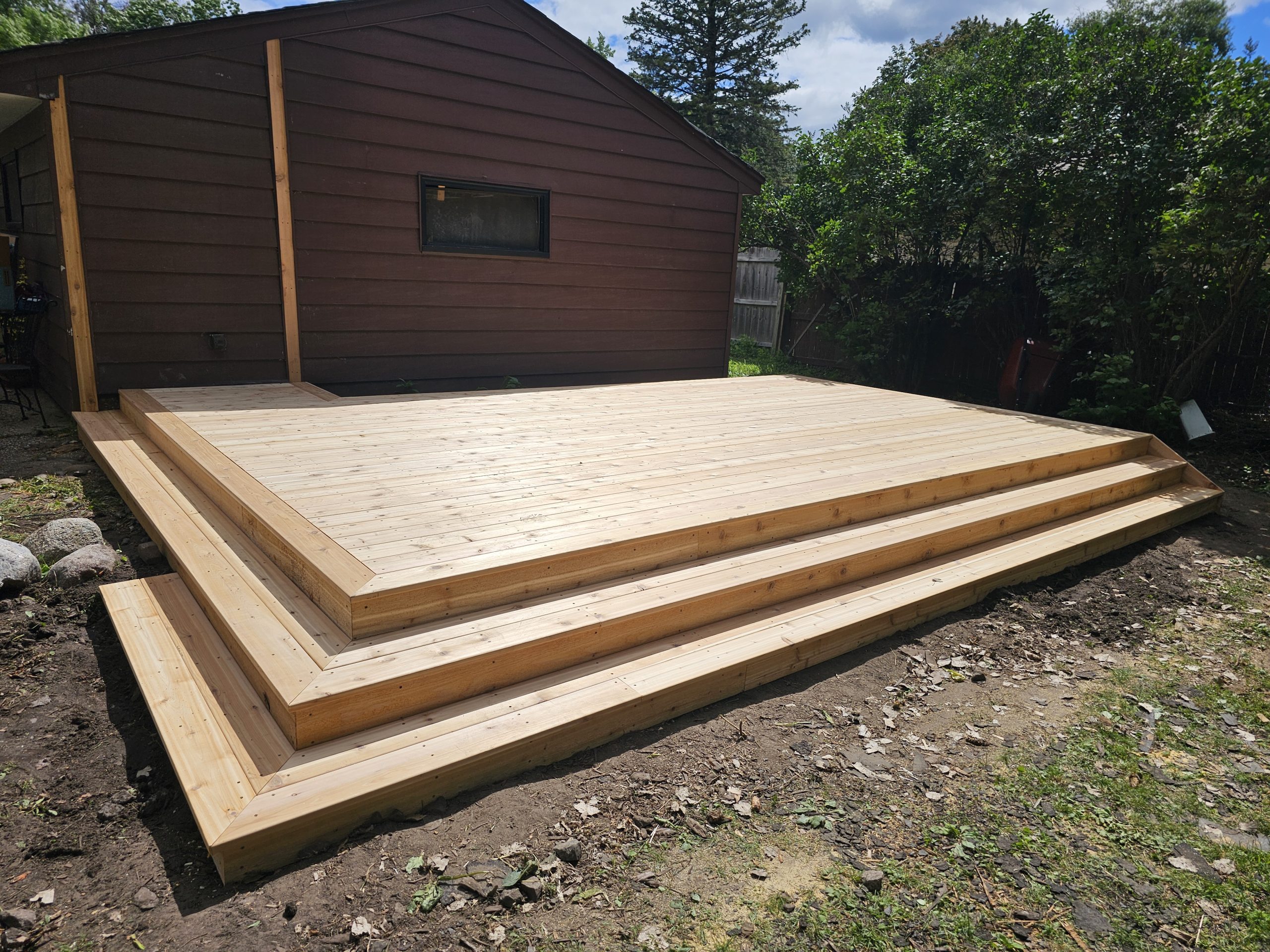
To guarantee your deck’s longevity, you’ll need to implement a robust maintenance routine. Regular cleaning, protective treatments, and timely repairs are essential components of deck upkeep. By following these practices, you’ll extend your deck’s lifespan and maintain its aesthetic appeal for years to come.
| Maintenance Task | Frequency | Benefits |
|---|---|---|
| Cleaning | Bi-annually | Prevents mold and mildew |
| Sealing/Staining | Every 2-3 years | Protects wood from moisture |
| Inspection | Annually | Identifies potential issues early |
Regular Cleaning Techniques
For the longevity of your deck, regular cleaning is essential. You’ll need to implement a consistent maintenance routine to keep your deck in prime condition.
Begin by sweeping the surface to remove loose debris, leaves, and dirt. This simple step prevents the accumulation of organic matter that can lead to mold and mildew growth. Next, use a garden hose or pressure washer to rinse the deck thoroughly, paying close attention to corners and crevices where grime tends to collect.
For a deeper clean, apply a deck-specific cleaner using a stiff-bristled brush or roller. Work the solution into the wood grain, focusing on high-traffic areas and stubborn stains. Allow the cleaner to sit for the manufacturer-recommended time before rinsing thoroughly.
Are there signs of mildew? If so, use a mixture of oxygen bleach and water to combat the fungal growth. Remember to protect surrounding vegetation when using cleaning solutions.
After cleaning, inspect your deck for any loose boards, protruding nails, or signs of rot. Address these issues promptly to prevent further damage. Finally, consider applying a water-repellent sealer annually to protect the wood from moisture damage and UV rays, extending your deck’s lifespan considerably.
Protective Treatments Application
Applying protective treatments is crucial for maintaining your deck’s longevity and appearance. You’ll need to select the appropriate treatment based on your deck’s material, typically choosing between sealers, stains, or paint. For wooden decks, water-repellent sealers offer basic protection, while semi-transparent stains provide both color and UV resistance.
How often should you apply these treatments? It depends on factors like weather exposure and foot traffic, but generally, you’ll need to reapply every 1-3 years.
Before application, guarantee your deck is clean and dry. You’ll want to check the weather forecast, as most treatments require 24-48 hours of dry conditions to cure properly. When applying, use a brush, roller, or sprayer, working in the direction of the wood grain. Don’t forget to treat the end grains and hard-to-reach areas.
Are you considering a clear sealer? Remember, while it preserves the natural wood look, it offers less UV protection than tinted options. For maximum longevity, consider using a high-quality, oil-based stain that penetrates deeply into the wood fibers, offering superior protection against moisture and sun damage.
Repair and Replacement
Even the best-maintained decks will eventually require repairs or partial replacements. As a deck owner, you’ll need to be vigilant in identifying signs of wear and tear, such as loose boards, protruding nails, or areas of rot. Regular inspections, particularly after severe weather events, can help you catch issues early and prevent more extensive damage.
When you notice problems, it’s essential to address them promptly. For minor repairs, such as replacing a few boards or tightening fasteners, you might be able to handle the work yourself. However, for more significant issues, like structural damage or extensive rot, it’s advisable to consult a professional deck builder. They can assess the extent of the damage and recommend appropriate solutions.
In some cases, partial replacement of deck sections may be necessary. This could involve replacing damaged joists, beams, or a substantial portion of the decking. When considering repairs or replacements, factor in the age of your deck and the cost-effectiveness of the work. At a certain point, it may be more economical to replace the entire deck rather than continually investing in repairs. How long should a deck last? With proper maintenance, most wood decks can last 15-20 years, while composite decks may last 25-30 years or more.
Frequently Asked Questions
Can I Build a Deck Myself to Save Money?
Yes, you can build a deck yourself to save money. It’s a challenging but rewarding DIY project. You’ll need basic carpentry skills, proper tools, and time. Be sure to check local building codes and obtain necessary permits before starting.
How Long Does It Typically Take to Construct a Deck?
You’ll find that deck construction time varies widely. It typically takes 1-3 weeks for professionals, but if you’re DIYing, expect 2-6 weeks. Factors like size, design complexity, and weather can impact your timeline considerably.
Do I Need a Permit to Build a Deck?
You’ll likely need a permit to build a deck. Check with your local building department, as requirements vary by location. They’ll consider factors like deck size, height, and attachment to your home when determining permit necessity.
What’s the Best Season or Time of Year to Build a Deck?
You’ll find spring or early fall ideal for deck building. It’s not too hot or cold, and there’s less rain. You’ll avoid summer’s high lumber prices and winter’s freezing temperatures that can hinder construction.
How Does Adding a Deck Affect My Home’s Resale Value?
Adding a deck can considerably boost your home’s resale value. You’ll likely recoup 60-80% of the cost when selling. It enhances your living space, improves curb appeal, and attracts potential buyers looking for outdoor entertainment areas.

